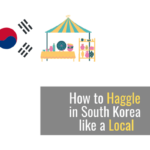Suggestions in Korean
Bargaining Strategies in Korean
Practical Ideas & Resources
Resources in this section curated by: Hanna LaPointe, Emma Rollo

Traditional markets are windows into lifestyles | News Article
This article discusses how bargaining is often an expected and welcomed practice in Korean markets. It also explains their history, going into depth about how markets were not just a place to exchange goods but also to share news and conversation. Lastly, it highlights particularly popular markets such as 남대문, and how demand for market products has shifted since the growth of modern stores and online shopping. The article does a great job of covering the different bases of Korean markets; learners looking to get form base knowledge would benefit from reading it closely.

Top 10 Must-Know Korean Phrases for shopping | YouTube Video
This video covers not just bargaining phrases, but also other common shopping phrases. The sentences described are frequent in everyday interactions. Learners wanting to get a better grasp on the overall subject can use this video. As bargaining typically happens at the end of an interaction (i.e., after the desired size and color has been found), being able to handle the interaction leading up to that time is important in order to be able to reach that time.

How to Haggle in South Korea and Save Tons of Money | Web Page
This guide, written by a Korean named Minjung, is very comprehensive in its coverage of the background of haggling, the culture around it, tips for successful communication in a variety of market types (such as traditional, electronics, or department stores), prominent markets in South Korea, and ends with a ‘Frequently Asked Questions’ section.
A key interaction the author notes is the 마수걸이 or ‘first sale of the day’; Korean sellers tend to believe that their first sale predicts how the rest of the selling day will go, and thus are more likely to accept a customer’s haggle if they are the first one in the store that day. She also addresses 4 aspects important to successful haggling: 눈치, 기분, 정, and 체면, and how they relate to bargaining with a seller.

Korean culture - What is Jeong?! | YouTube Video
This video by FeelKo describes another important concept related to Korean culture called 정, or jeong. The Korean people have difficulty defining it, but somewhat agree that it is ‘affection, being fond of’. One person explains how in Korean traditional markets, sellers give him more food than he pays for in order to look out for him as if they were related. Another person describes it as an unsaid way of showing those around you that you care about them. When it comes to bargaining, 정 is important because it can explain why sellers may be willing to give a discount and why buyers should be respectful and not try to bargain too much or for too high a discount; each party should be looking out for the other.

Learn the Five Must-Know Phrases for Bargaining in Korean | YouTube Video
YouTuber 한국언니, a expert Korean speaker, explains common bargaining tactics used in Korean shops. She explains both indirect and direct requests (for example, one phrase is ‘It’s so expensive’, suggesting a speaker wants a seller to reduce the cost, while another, ‘Please reduce the price a little bit’ is much more direct with its illocutionary force). This video demonstrates the pragmatic strategies needed for Korean haggling and provides good examples for learners aiming to practice haggling in real-life situations.

Korean-Australians explain the word noonchi/nunchi | YouTube Video
This video by the YouTube channel KOZZIECOM interviews 3 Korean-Australians about the meaning of the word 눈치. The interviewees demonstrate how difficult it is to fully describe, especially when someone isn’t Korean. They generally describe it as being witty, how well you can read a situation, and knowing your place. As the concept is very interpersonal, it is important to have good 눈치 when it comes to bargaining with market sellers.

To haggle or not to haggle in Seoul? | Online Forum
This forum comes from the popular travel website Tripadvisor. In this example, one user begins a forum by asking if haggling for products is required for shopping in Korea. Users who responded tended to agree that although not required, haggling is appropriate in some types of stores (i.e., ones that don’t have marked price tags). One user presents another aspect common in Korean shopping: The idea that shopkeepers believe the first shopper of the day determines how well their products will sell that day. This forum heavily discusses the cultural factors and pragmatic aspects of bargaining and the situations in which it’s appropriate to do so.

Thrifting in Seoul: Tips from a Pretty & Stylish Korean LOL | YouTube Video
This video shows Korean YouTuber Jina Kim going shopping at the popular market 광장시장. She interacts with different shopkeepers in Korean, and as a result, shows common communication patterns between buyer and seller. She also emphasizes that dressing younger helps in getting discounts on items (as sellers will assume a younger person doesn’t have as much money to spend as an older person). Viewers can use this video to practice listening and introduce themselves to common bargaining behavior from a Korean person’s perspective.

Seoul Fake Market Spree! | YouTube Video
In this video, American YouTuber Collin shopping at the popular market 명동시장. While the shopper speaks only in English for the duration of the video, it’s useful in demonstrating many sellers’ openness to haggling and willingness to drop prices, even in a nonnative language. Viewers can learn about common phrases used by sellers to rebuke offers such as “안 돼(요)” (“I can’t (go that low)”), as well as seller body language and sellers’ preference for cash offers over card offers.

[선공개] 외국인의 흥정 시도, 재래시장에서 먹힐까? | YouTube Video
This video is another example showing bargaining. Despite the two tourists not being very familiar with the Korean language, they manage to communicate with and bargain with the sellers at a traditional market. The hosts of the program remark that the phrase they use, “깎아주세요” is a well-renowned bargaining comment. The video is also helpful in showing the atmosphere and typical setup of a traditional market.

Biggest Traditional Market in Korea Vlog! | YouTube Video
This video shows a Korean host, Korean 언니, touring the biggest traditional market in South Korea, 남대문 market. The host provides an overview of the market, its history, and how to navigate the sprawling market effectively. As 남대문시장 is located in the heart of Seoul and has a wide assortment of products, it is popular with native Koreans and tourists alike.
